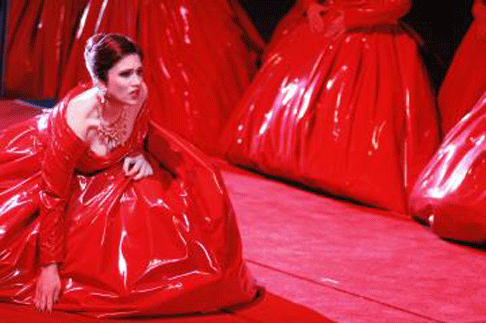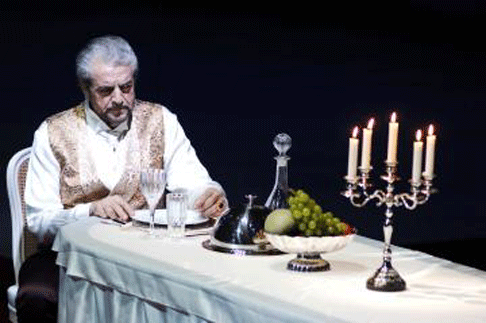For starters, it is uncommonly well sung and played with authentic style and
real Italian ardor. One has come to expect such top tier musical quality from
this marvelous Swiss company. But the surprising marvel of the evening was a
wholly modern “concept” production that not only offered thrilling
visiuals, but also uncompromising clarity.
Anyone who reads the pages of virtually any opera-related publication is
well aware of the profusion of so-called “Eurotrash” productions
that litter (word chosen carefully) the theatrical landscape, willfully
undermining the work of art they are meant to serve, running perversely counter
to the authors’ intentions, or just plain setting out to create an
entirely un-related work casually relegating the music and drama to second
banana status as a means to some sort of arrogantly pretentious
“end.”
All the more remarkable then, that such a surreal production could pack such
a wallop. How? Set designer Paolo Fantin used the ‘‘elements”
as a basis for his breath-taking design. The island of the opening scene
consisted of a weighty, over-sized, tilted writing desk, littered with books,
and bearing its lone citizen: our troubled hero Corrado. Mr. C attempts to
script letter after letter to his beloved only to crumple them and discard them
in the sea. The desk floated and spun on a water-filled stage, backed by a huge
tilted mirror wall that reflected the assembled forces as if from above. This
provided a sensational kaleidoscopic effect that combined the best efforts of
‘performance art’ and contemporary ‘living’
sculpture.
The side mirrors could rise and fall when necessary to admit choristers or
other scenic elements, chief of which was a huge floating/spinning bed that
bore our soon-to-be-unhinged heroine Medora. ‘Earth’ consisted of a
long narrow platform that tracked in to intersect the water, and occasionaly
bringing with it an enormous dining table put to good use as a symbolic prop
and another level as a playing area.
The front of the stage was outfitted with gas jets, so when the invaders set
the town on fire, Corrado summoned the flames Wotan-like to appear, and appear
they did, creating a dazzling wall of fire between us and the players,
brilliantly multiplied by the mirrors.
Mr. Fantin had a willing accomplice in costume designer Carla Teti, who not
only handsomely outfitted her male cast in rather traditional period attire,
but served up some fantastical robes for the chorus, and eye-popping, shiny red
plastic ball gowns for Gulnara and the Damenchor’s first scene. The riot
of color and movement created by these crimson reflections was evocative of
strewn poppies being carried by the wind. Wow!
I am not sure how difficult it must be to light all of this effectively,
what with all the possibilities for blinding the audience with all those shiny
surfaces, but Martin Gebhardt’s lighting design was just remarkable in
its many effects, not the least of which was a really decent general wash when
required.
 Carmen Giannattasio as Gulnara
Carmen Giannattasio as Gulnara
Director Damiano Michieletto provided an assured staging that was lean and
mean. He chose to confine the action to a smallish playing space for each
scene, and to concentrate on intensely personal and specific interactions
between the characters. What a concept! Actors listening to, and reacting to
each other! If just this basic tenet caught on, many a Euro-trash production
could improve 50%!
The tense duet between Seim and Gulnara was heightened to searing
proportions by having the baritone unceremoniously heave her onto the dining
table and begin to strangle her amid the fine china and flower arrangements, a
shocking juxtaposition of uncivil behavior amid all the trappings of civility.
Having Corrado and Medora play their entire first duet on her careening bed,
not only added a hint of a carnal dimension, but more important, underscored
and presaged her character’s fragility and instability. Throughout the
night, Mr. Michieletto’s sure hand gave us telling stage pictures,
focused drama, and (not inconsequential) wonderful traffic management of the
large choral forces (singing dynamically under Chorus Master J¸rg H‰mmerli).
But all this would have been for naught had the music been ill-served, and
here we were equally favored. For, as the Corsair of the title, Vittorio
Grigolo is the real deal. There was not one moment that Mr. Grigolo was not
fully committed to his portrayal, dramatically engaged, and interacting
deferentially with his colleagues. He has a clean lyric tenor with some heft in
the core sound, and while he is often singing at the limit of his current
resources, the good news is he never attempts to exceed his capabilities. He is
young, he is handsome, he is gifted with a meltingly beautiful instrument, and
he is pacing himself well without ever stinting on emotionally-charged, arching
lines. It is hoped that he does not just yet sing this role too often, or
attempt such parts in a larger house, but note for note, this was star singing
with superstar potential. Vittorio is a tenor to watch.
As Medora the reliable Elena Mosuc provided some bell-like fioriture and
seamless flights above the staff. Her limpid tone was a terrific match for
Grigolo’s in the warmly lyrical passages and she offered a very clear
understanding of our heroine’s dramatic journey. In one of the few minor
staging miscalculations, Ms. Mosuc’s superb vocalizing in her final mad
scene was unnecessarily competing with the ladies sloshing through the water,
strewing flowers (as noiselessly as they could, but distracting nonetheless). I
would challenge the director to find a way to keep the wonderful effect but
perhaps move it to a different moment.
 Juan Pons as Seid
Juan Pons as Seid
Carmen Giannattasio (Gulnara) was new to me and what discovery she was,
taking the stage from her first entrance and commanding our attention with
ravishing phrasing, assured histrionics, and complete command of early Verdi.
Ms. Giannattasio’s dusky soprano has a hint of metal, meaning she crested
the climaxes with fine effect. Early on, I worried I might tire of her
no-nonsense delivery. But she soon proved herself capable of well-controlled
introspective phrases and moments of hushed, haunting piannissimi. I hope to
encounter her again.
Stalwart veteran Juan Pons as Seid is in the autumn of a long and
distinguished career. Mr. Pons is still a formidable figure and consummate
professional, and he performs with fearless bravado. If his substantial
baritone still has the presence and volume of old, it has to be conceded that
years of Scarpia’s and Tonio’s et al. have left the
instrument a little woolly around the edges. But his imposing artistry proved a
perfect foil for the three fresh-voiced “youngsters” in the
cast.
And speaking of youth: in the pit young Eivind Gullberg Jensen led quite a
stylish account of this equally youthful score. At all times, he displayed a
real flair for the genre, and the maestro inspired his talented performers with
an evident love of the piece. His belief in Verdi’s early effort was
infectious and we all willingly succumbed to his committed rendition.
This hit performance of Il Corsaro (wildly cheered) offered
sure-handed direction in a visually pleasing physical production married to
superlative playing and singing that included a rising star tenor: the best of
both worlds, indeed.
James Sohre
image=http://www.operatoday.com/403_DSC_0062_1.gif
image_description=Vittorio Grigolo as Corrado [Photo courtesy of Opernhaus Z¸rich]
product=yes
product_title=
product_by=Carmen Giannattasio (Gulnara), Elena Mosuc (Medora); Vittorio Grigolo (Corrado), Giuseppe Scorsin (Giovanni), Juan Pons/Renato Bruson (Seid), Michael Laurenz M¸ller (Eunuco), Pablo Ricardo Bemsch (un schiavo), Shinya Kitajima (Selimo). Conductor: Eivind Gullberg Jensen. Producer: Damiano Michieletto. Set design: Paolo Fantin. Costumes: Carla Teti. Lighting: Martin Gebhardt. Orchester der Oper Z¸rich. Chor der Oper Z¸rich
product_id=Above: Vittorio Grigolo as Corrado
All photos courtesy of Opernhaus Z¸rich